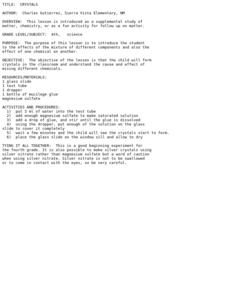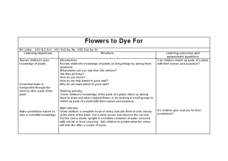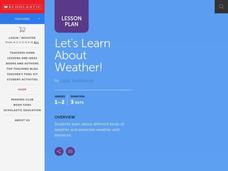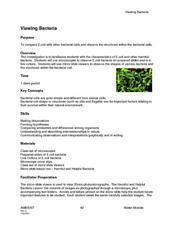Curated OER
Crystals
Fourth graders use mucilage glue and magnesium sulfate to make crystals. They mix the ingredients, place a drop on a glass slide and observe the forming crystals.
Curated OER
The Circulatory System - Part I
First graders consider what effect their behavior has on their health. Students make a fist to indicate the size of his/her heart. They complete a worksheet on the heart, coloring the arteries red and the veins blue.
Curated OER
Flowers to Dye For
Students observe biology by completing a plant experiment in class. In this botany lesson, students discuss the anatomy related to a plant and how roots and stems are necessary to its survival. Students utilize food coloring and examine...
Curated OER
Traits Needed for Effective Group Process
Students brainstorm characteristics that are needed to succeed in various occupations. They observe the list and discuss the most-listed traits. The list is left up in the classroom for inspiration.
Curated OER
First Impressions
Students discuss the importance of not making assumptions when only little information is known. With a partner, they complete a worksheet in which they only look at them to figure out what they like, etc. Next, they ask them the...
Curated OER
Anonymous Card Delivery
Students brainstorm a list of people who would benefit from an anonymous card. They then make the card and deliver it. A journal will be created by them to record their feelings of how they felt doing this act and expecting nothing in...
It's About Time
Reflected Light
The lesson allows young scientists to use lasers and mirrors to study reflected light. A reading passage and homework question assess learning, while additional material introduces extension activities.
Nuffield Foundation
Measuring Rate of Water Uptake by a Plant Shoot Using a Potometer
How quickly does a plant transpire? Learners explore this question through measuring water uptake with a potometer. They time the movement of a bubble a set distance to understand the motion and rate of speed.
Scholastic
Discussion and Dissection of an Owl Pellet
Young scientists get the chance to dissect pellets "owl" by themselves to determine the owls environment and nourishment. This is the third part of a three-part series.
Code.org
Check Your Assumptions
Always check your assumptions when interpreting data and data visualizations. That's the take away from this exercise. Class members examine a failed project that looks at search trends to predict flu outbreaks and consider the...
NOAA
Satellite Communications
How do satellites communicate? What types of satellites orbit Earth? Discover and mimic the way satellites communicate between two points in a hands-on activity that has pupils using mirrors, flashlights, and marbles.
Curated OER
Unnatural Selection
Students identify quotation marks and demonstrate the uses of quotation marks. They rewrite sentences without quotation marks and discuss how the meanings can change without the use of quotation marks. In addition, they make their own...
Curated OER
Strands Walk An Ecological Observation
Students examine an ecosystem and analyze the role of two abiotic factors in the ecosystem. In this ecosystem lesson plan students complete an activity on their ecosystem.
Curated OER
Detecting Magnetic Materials in "Martian" Soil
Pupils simulate some of the Pathfinder experiments by devising methods of collecting and measuring magnetic substances in pseudo-Martian soil. The efficiency of each of the methods used to collect materials is evaluated in this lesson.
Curated OER
Lab Report Template
In this biology worksheet, learners complete a lab report being as detailed as possible. They identify the problem or hypothesis. Then they write the procedures and record their findings. Students also analyze their results, discuss, and...
Curated OER
Observation of a Living Earthworm
Sixth graders examine earthworms and their parts. In this earthworm instructional activity students complete a lab worksheet on the earthworm and test its response to certain factors.
Curated OER
This Stuff Makes Me Sick
Pupils participate in a lab showing the effects of pesticides on Lumbriculus variegatus. Several extensions and variations are also included in this lesson including one which relates the experiment to how pesticides enter our drinking...
Curated OER
John Muir Nature Journal
Students explain how John Muir carefully and quietly observed nature and record his observations in his journal with writings and drawings. Students create their own nature observation journal.
Curated OER
Let's Learn About Weather!
Students read several weather-related stories. They brainstorm weather words and use them as they make a weather booklet that includes pictures, a story of their own, and observations they make about the weather outside on that day.
Curated OER
Flowers, Pods, and Seeds
Young scholars gain an understanding of living organisms. the complete a plant growth data log to chart plant growth and to make observations, predictions, and personal reflections.
Curated OER
Water Quality in the Greenhills Stream
Seventh graders conduct year long study of water quality over different seasons using variety of probes, including D.O., pH, conductivity and temperature, that are attached to portable technology. Students select three data points in...
Curated OER
Clouds and Your Weather
Seventh graders identify clouds and the weather associated with them. They use informational articles and personal weather observations to learn about the relationships between weather fronts and clouds.
Curated OER
Oobleck
First graders explore Oobleck. They manipulate and observe the properties of Oobleck. Students discuss the differences between solids and liquids. They investigate Oobleck. Students write a sentence describing what they observed about...
Curated OER
Viewing Bateria
Students use microscopes to observe E. coli bacateria on prepared slides and in a live culture. They use micro-slide viewers to observe the shapes of various bacteria and the structures within the bacterial cell. Students make an...























